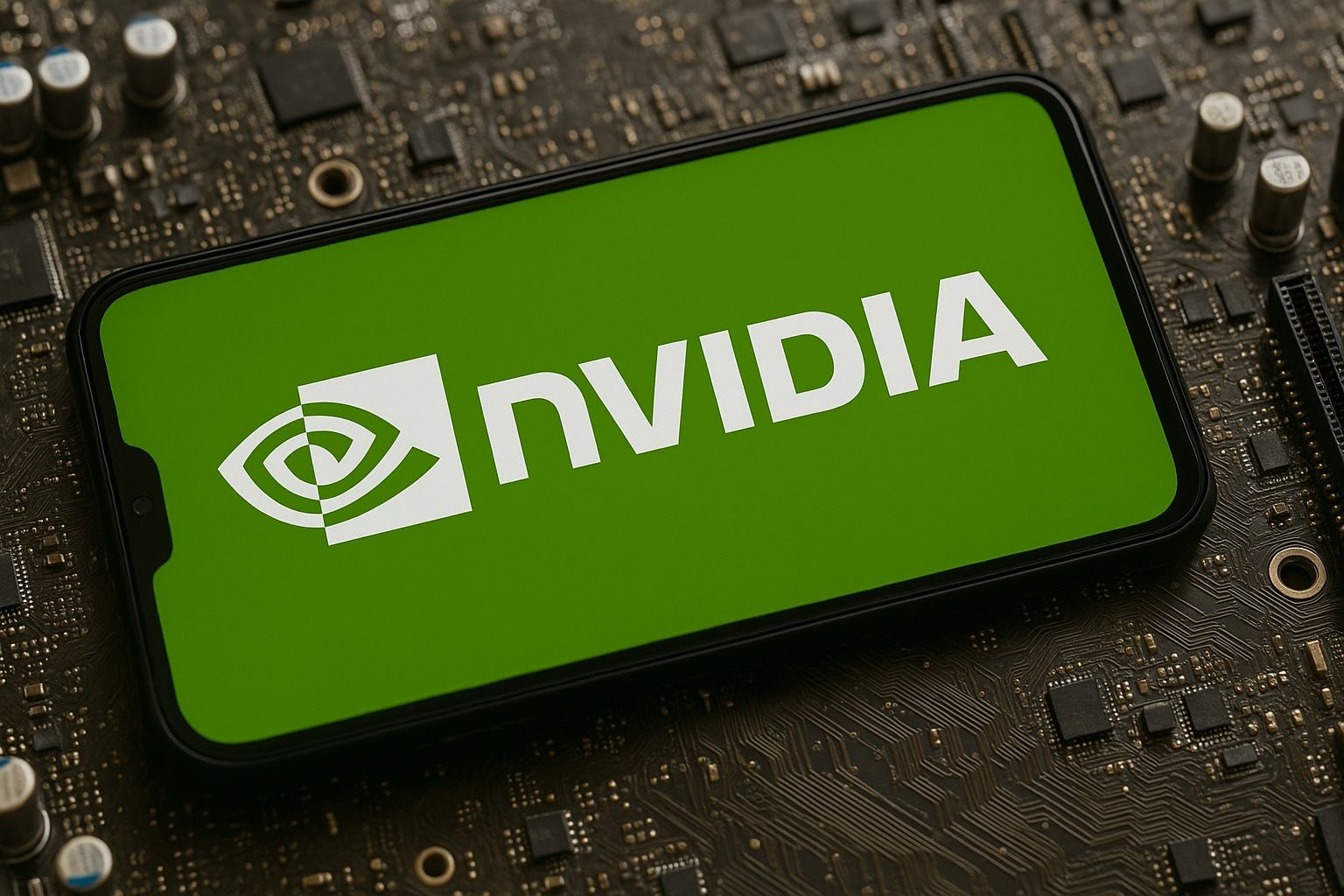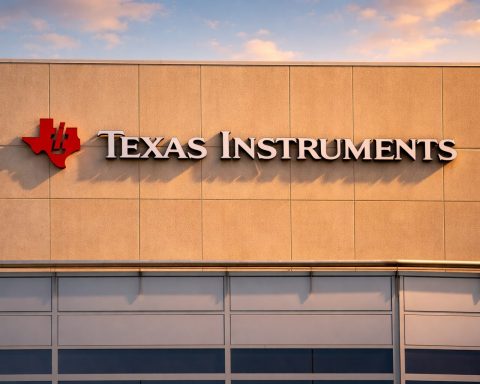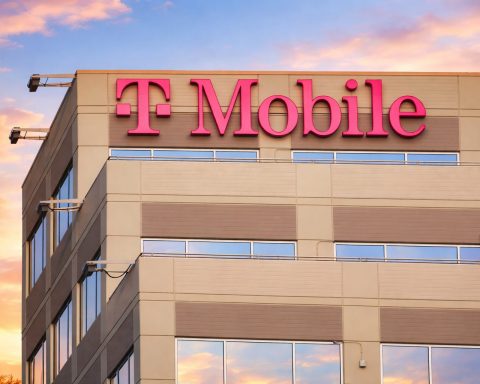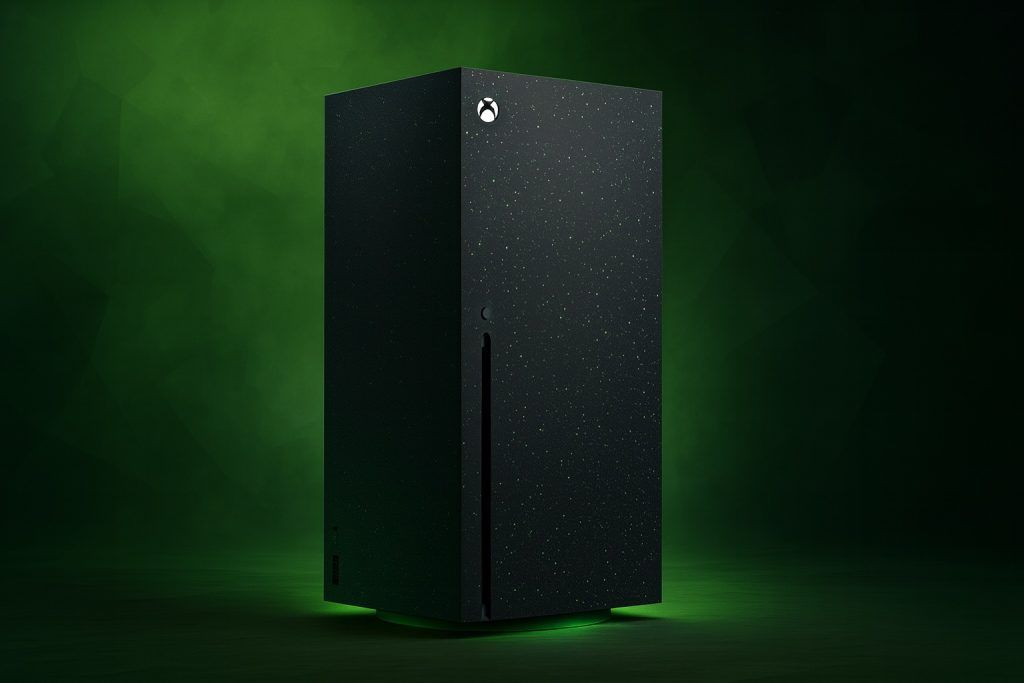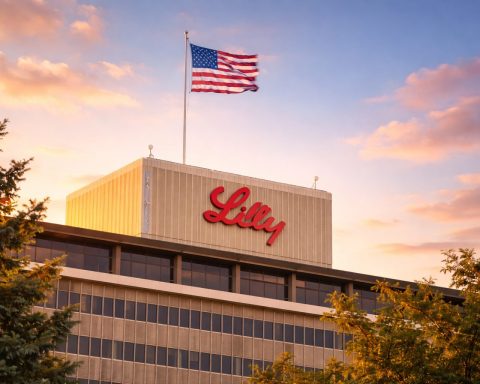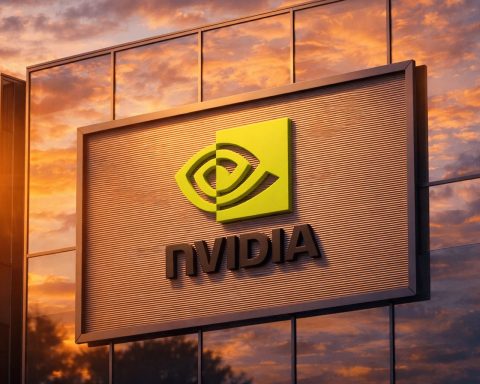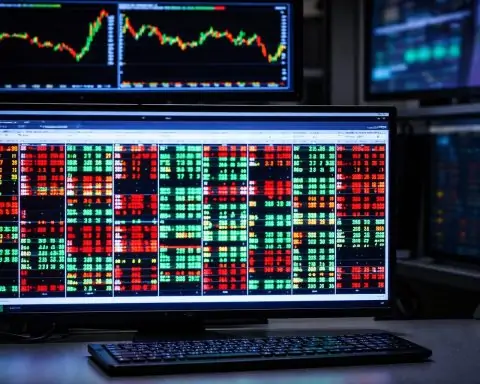- Nvidia up ~58% YTD: NVDA trades around $180–182 (Oct 22, 2025), just shy of its all-time high (~$195) [1]. Its market cap is roughly $4.4 trillion [2].
- AI revenue surge: Q2 FY2026 revenue hit $46.7 B (+56% YoY) [3], with $41B from data-center GPUs (≈88% of sales) [4], validating the AI demand story.
- Mega-deals announced: Nvidia agreed to invest in xAI’s $20B GPU financing (Nvidia stake ~$2B) [5] [6]. It also struck a $100B AI-computing partnership with OpenAI [7] and took a $5B stake in Intel in a joint chip venture [8].
- Analysts remain bullish: Over 90% of analysts rate NVDA a “Buy” [9]. Average 12-month targets cluster in the $210–220 range (≈15–20% above today) [10], with some extremely high forecasts (HSBC at $320 [11]; Cantor raised target to $300 [12]).
- Risks and competition: Nvidia’s valuation (~50× forward earnings) is sky-high [13]. Rising rates and profit-taking recently pulled NVDA off its peak [14]. U.S.–China tech tensions and new export curbs could chip away at sales (China accounts for ~10–15% of revenue [15]), and rivals (AMD, etc.) are landing big AI deals [16].
In short, Nvidia’s stock has surged again on the back of the latest AI deals and partnerships. The combination of blockbuster AI earnings, strategic alliances, and massive investor enthusiasm has propelled NVDA toward record territory [17] [18] – leaving the market asking if the rally can continue (some analysts even eye a $300 price by year-end [19]).
AI Frenzy Propels Nvidia’s Growth
The AI revolution is driving an unprecedented boom in demand for Nvidia’s chips. In its latest quarterly report (FY2026 Q2, May–Jul 2025), Nvidia blew past expectations with $46.7 B revenue, up 56% year-over-year [20]. Virtually all of that growth came from AI: $41 B (≈88%) was from its data-center GPUs, which power generative AI models [21]. Gross margins exceeded 72% and net margins topped 50% [22], a level of profitability that is almost unheard-of at this scale. Those results cemented Nvidia’s role as the backbone of the AI boom.
Investors rewarded the results by bidding Nvidia’s market value into the stratosphere. In early October, NVDA briefly became the world’s most valuable company – its market cap briefly eclipsed $4.5 trillion [23] [24]. Today it sits around $4.4 trillion, dwarfing competitors (roughly 10× AMD and 30× Intel combined [25]). Wall Street pundits note that this implies a roughly 50× trailing earnings multiple [26]. Bulls argue that Nvidia’s revenue is still accelerating (consensus sees ~34% revenue growth next year [27]), which could justify such lofty multiples. Skeptics counter that “at these heights Nvidia is priced for perfection” – any hiccup could trigger a sharp sell-off [28].
Indeed, NVDA stock has become volatile. After peaking above $195 in early October [29], rising interest rates and profit-taking sent the stock tumbling about 4% on Oct. 14, down to ~$180 [30]. By Oct. 22 it had rebounded into the low-$180s [31]. As one market observer put it, “Nvidia enters the week as a market darling” – still in the spotlight despite bouts of volatility [32]. At the current price (~$180), NVDA is up roughly 58% year-to-date, vastly outperforming the S&P 500. The stock’s ability to ride through market sell-offs reflects how entrenched Nvidia has become in the AI narrative [33].
CEO Jensen Huang has underscored this momentum, calling Nvidia’s new “Blackwell” AI chip architecture “the AI platform the world has been waiting for,” with production ramping up to meet “extraordinary” demand [34]. Huang also recently unveiled plans for next-generation “AI factories” – essentially massive, power-rich data centers dedicated to training AI models [35]. Nvidia even shipped DGX Spark, touted as “the world’s smallest AI supercomputer,” to help researchers develop AI on desktops [36]. All these efforts are aimed at staying several steps ahead of the competition.
Musk’s xAI Raises $20B for Nvidia GPUs
One headline-grabbing event has been Elon Musk’s AI startup xAI securing financing to lease Nvidia chips. In early October it was reported that xAI is raising a staggering $20 billion (debt and equity) to fund its data center Colossus 2, and Nvidia is front-and-center in the deal [37]. Nvidia is committing up to $2 billion of equity to the round [38] [39]. The structure: about $7.5 billion in equity (with Nvidia’s $2B), and up to $12.5 billion of debt, all tied to Nvidia’s GPUs [40]. A special-purpose vehicle will actually buy the GPUs from Nvidia and lease them to xAI for five years [41] – a novel financing scheme that secures Nvidia hardware while giving investors a return via chip “rentals.”
When news broke on Oct. 8, Nvidia stock reacted immediately. Shares jumped 2.2% that day, closing at $189.11 [42], as investors cheered the deeper partnership with Musk’s AI venture. (After-hours they consolidated slightly, dipping 0.06% to $188.99 [43].) The deal highlights how Nvidia is evolving from a chip seller into a financing engine for AI: the parameter.io report notes it “reflects Nvidia’s growing strategy to finance AI infrastructure while deepening ties across the sector” [44].
This xAI arrangement is arguably bullish for Nvidia’s long-term sales – it essentially locks up thousands of high-end GPUs for Musk’s AI efforts [45] [46]. Analysts point out that any deal that guarantees chip off-take is a plus for Nvidia. (In fact, in September Musk refuted earlier rumors of a smaller $10B raise, emphasizing that a funding round was coming but not right away [47].)
Other Strategic Partnerships and Investments
Nvidia has been aggressive on multiple fronts to cement its AI dominance. OpenAI: In late September the companies announced a landmark $100 billion partnership to build at least 10 gigawatts of Nvidia GPU supercomputers for OpenAI [48]. In practice, Nvidia will deploy millions of GPUs in OpenAI’s data centers, and commit up to $100B of investments (through hardware and funding) as the infrastructure is built [49]. This alliance effectively ties Nvidia’s fate to OpenAI’s success – a symbiotic lock-in that was unthinkable before the AI boom.
Intel: In September Nvidia stunned the industry by investing $5 billion in longtime rival Intel – roughly a 4% stake [50]. The goal is a strategic partnership: Intel will supply CPUs and packaging, and together they will co-develop new PC and data center chips [51]. (Crucially, Nvidia’s chips will still be fabbed by TSMC, but Intel’s fabs may aid scale.) The bold move shored up Intel – its stock jumped 23% on the news [52] – and gave Nvidia a role in strengthening the U.S. chip ecosystem. Huang noted the deal aligns with U.S. goals to bolster domestic semiconductor capabilities [53].
Data Centers: Nvidia joined a consortium (with BlackRock, Microsoft, and others) to buy Aligned Data Centers for $40 billion [54]. Aligned operates ~80 hyperscale data centers (5 GW capacity) – essentially locking in space and power for Nvidia’s chips as AI demand expands. BlackRock’s CEO Larry Fink said the acquisition was to “deliver the infrastructure to power the future of AI,” and Nvidia’s CEO at a shareholder firm noted they’re “looking at rapid expansion to meet AI demand” [55].
New Products: On the hardware side, Nvidia recently rolled out its GeForce RTX 50-series GPUs (with AI-boosted gaming features) and began shipping DGX Spark micro-supercomputers [56]. It also produced the first U.S.-made wafer of its next-gen Blackwell chip in Arizona [57], a milestone for onshore production. All signs point to Nvidia plowing its enormous cash flow into securing its lead at every layer of the AI stack [58].
Wall Street Outlook and Forecasts
Analysts are overwhelmingly bullish on Nvidia’s prospects – despite the already sky-high valuation. Over 90% of analysts rate NVDA a Buy [59]. The average 12-month price target is in the low-$200s (15–20% above current levels) [60]. Some forecasts are even more aggressive: for example, Cantor Fitzgerald lifted its NVDA target to $300 (from $240), implying ~60% upside [61]. HSBC set a street-high $320 target [62]. One Wall Street analyst was quoted saying “AI is the real deal,” and called Nvidia “the premier way to invest in that trend” [63]; another dubbed Nvidia the “leader of the generative-AI golden wave” [64].
Even so, not everyone is complacent. Nvidia trades at roughly a 50× forward P/E [65] – far above the sector average. Morgan Stanley notes the global market for AI infrastructure is huge but will require sustained capital expenditures. As MarketBeat observes, analysts have been raising NVDA forecasts in recent weeks [66]. Nearly all are projecting continued 50+% revenue growth in FY2025 and beyond. If Nvidia meets or beats these lofty expectations (and guidance is strong), the stock could remain bid up. (In fact, NVDA’s consensus was a record ~$16B revenue for Q3 and analysts widely expect another monster quarter [67].)
Conversely, any earnings miss or slowdown in AI capex could trigger a pullback. As one market analyst warned after Q2 earnings in August, “with the stock trading at such a high valuation, any bad news was going to be punished” [68]. Indeed, after Q2 results in late August (beating forecasts but with slightly lower data-center growth than expected), NVDA fell about 3% in after-hours trading [69]. That correction momentarily eased the hype, but Nvidia quickly resumed its climb. For now, investors seem willing to “buy the dip” on NVDA, buying weakness because they trust the AI story [70].
Near-Term Outlook and Risks
As of Oct. 23, 2025, Nvidia’s stock is near record highs on booming fundamentals and bullish sentiment [71] [72]. Looking ahead, Nvidia will announce Q3 earnings on Nov. 19, with Street estimates calling for another quarter of hefty growth [73]. If those numbers come in hot, the rally could continue. On the other hand, the market will be watching for any signs that Nvidia’s growth is finally cooling or that AI investment saturates.
Key risks include macroeconomic and geopolitical factors. U.S. interest rates and bank stresses could damp technology spending, as recent market swings have hinted. More importantly, U.S.–China trade tensions loom large for Nvidia: its most advanced GPUs remain banned from China, which accounts for roughly 10–15% of sales [74]. Any diplomatic breakthroughs at the upcoming Asia-Pacific Economic Cooperation (APEC) summit could be a game-changer. Nvidia CEO Jensen Huang will attend the APEC CEO meeting (Oct 28–31) in South Korea [75], meeting with Korean tech chiefs (Samsung, SK Hynix) and others. Coincidentally, U.S. President Trump is scheduled to meet Chinese President Xi at APEC [76]. Any easing of export controls – or a new flare-up like China’s recent antitrust probe of Nvidia [77] – would directly impact Nvidia’s outlook.
Competition is another wild card. AMD, Nvidia’s biggest rival in GPUs, recently won a headline-grabbing order to supply up to 6GW of AI chips to OpenAI [78], and Oracle plans to deploy 50,000 of AMD’s new MI450 GPUs in its cloud [79]. These wins don’t dethrone Nvidia overnight – its H100 chip is still top-ranked – but they show that big AI buyers are willing to diversify. Other players (Intel-FPGA specialist Xilinx, Google’s TPU chips, etc.) are also vying for AI workloads. And large-scale AI is capital-intensive; Morgan Stanley estimates global AI infrastructure spending will reach ~$400 billion this year [80], with more to come. Nvidia must keep innovating to stay ahead of rivals on price, performance, and availability.
Conclusion
Nvidia is currently riding a juggernaut: blockbuster earnings, unprecedented data-center spending, and a string of strategic deals have made it the poster child of the AI revolution [81] [82]. Its stock sits near record highs on surging demand and bullish forecasts [83] [84]. Whether NVDA can sustain this pace depends on execution and external factors. Analysts note that as long as AI momentum persists and Nvidia continues delivering (and securing) more GPU capacity, its lofty valuation could be justified [85] [86]. But with much of that optimism “priced in,” even a minor stumble could trigger a sharp sell-off. Investors will be watching closely as Nvidia reports results in November and as global events unfold.
Sources: Recent market reports and analyses [87] [88] [89] [90], Reuters news wire [91] [92] [93], and Nvidia press releases [94] [95]. These include commentary from industry experts and analysts. All figures and quotes are from the cited sources.
References
1. ts2.tech, 2. ts2.tech, 3. ts2.tech, 4. ts2.tech, 5. www.reuters.com, 6. parameter.io, 7. ts2.tech, 8. ts2.tech, 9. ts2.tech, 10. ts2.tech, 11. ts2.tech, 12. www.barchart.com, 13. ts2.tech, 14. ts2.tech, 15. ts2.tech, 16. ts2.tech, 17. ts2.tech, 18. ts2.tech, 19. www.barchart.com, 20. ts2.tech, 21. ts2.tech, 22. ts2.tech, 23. ts2.tech, 24. www.barchart.com, 25. ts2.tech, 26. ts2.tech, 27. ts2.tech, 28. ts2.tech, 29. ts2.tech, 30. ts2.tech, 31. ts2.tech, 32. ts2.tech, 33. ts2.tech, 34. ts2.tech, 35. ts2.tech, 36. ts2.tech, 37. www.reuters.com, 38. www.reuters.com, 39. parameter.io, 40. www.reuters.com, 41. parameter.io, 42. parameter.io, 43. parameter.io, 44. parameter.io, 45. www.reuters.com, 46. parameter.io, 47. www.reuters.com, 48. ts2.tech, 49. ts2.tech, 50. ts2.tech, 51. ts2.tech, 52. ts2.tech, 53. ts2.tech, 54. ts2.tech, 55. ts2.tech, 56. ts2.tech, 57. ts2.tech, 58. ts2.tech, 59. ts2.tech, 60. ts2.tech, 61. www.barchart.com, 62. ts2.tech, 63. ts2.tech, 64. ts2.tech, 65. ts2.tech, 66. finviz.com, 67. ts2.tech, 68. www.reuters.com, 69. www.reuters.com, 70. finviz.com, 71. ts2.tech, 72. www.barchart.com, 73. ts2.tech, 74. ts2.tech, 75. www.reuters.com, 76. www.reuters.com, 77. www.reuters.com, 78. ts2.tech, 79. ts2.tech, 80. ts2.tech, 81. ts2.tech, 82. ts2.tech, 83. ts2.tech, 84. www.barchart.com, 85. ts2.tech, 86. ts2.tech, 87. www.reuters.com, 88. ts2.tech, 89. ts2.tech, 90. www.barchart.com, 91. www.reuters.com, 92. www.reuters.com, 93. www.reuters.com, 94. ts2.tech, 95. ts2.tech
